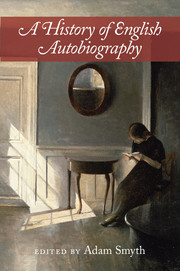Book contents
- Frontmatter
- Dedication
- Contents
- List of contributors
- 1 Introduction: The range, limits, and potentials of the form
- PART 1 AUTOBIOGRAPHY BEFORE ‘AUTOBIOGRAPHY’ (CA. 1300–1700)
- PART 2 RELIGION, GENDER, THINGS (CA. 1700–1800)
- 8 Structures and processes of English spiritual autobiography from Bunyan to Cowper
- 9 ‘Written by herself’: British women's autobiography in the eighteenth century
- 10 The lives of things: Objects, it-narratives, and fictional autobiography, 1700–1800
- 11 Empiricist philosophers and eighteenth-century autobiography
- PART 3 THE MANY NINETEENTH CENTURIES (CA. 1800–1900)
- PART 4 RELATIONAL LIVES AND FORMS OF REMEMBERING (CA. 1890–1930)
- PART 5 KINDS OF COMMUNITY (CA. 1930-CONTEMPORARY)
- Index
- References
10 - The lives of things: Objects, it-narratives, and fictional autobiography, 1700–1800
from PART 2 - RELIGION, GENDER, THINGS (CA. 1700–1800)
Published online by Cambridge University Press: 05 March 2016
- Frontmatter
- Dedication
- Contents
- List of contributors
- 1 Introduction: The range, limits, and potentials of the form
- PART 1 AUTOBIOGRAPHY BEFORE ‘AUTOBIOGRAPHY’ (CA. 1300–1700)
- PART 2 RELIGION, GENDER, THINGS (CA. 1700–1800)
- 8 Structures and processes of English spiritual autobiography from Bunyan to Cowper
- 9 ‘Written by herself’: British women's autobiography in the eighteenth century
- 10 The lives of things: Objects, it-narratives, and fictional autobiography, 1700–1800
- 11 Empiricist philosophers and eighteenth-century autobiography
- PART 3 THE MANY NINETEENTH CENTURIES (CA. 1800–1900)
- PART 4 RELATIONAL LIVES AND FORMS OF REMEMBERING (CA. 1890–1930)
- PART 5 KINDS OF COMMUNITY (CA. 1930-CONTEMPORARY)
- Index
- References
Summary
In the mid eighteenth century, things – coins, clothing, coaches, walking-canes, and writing implements – as well as animals – cats, dogs, birds, mice, and vermin – began to recount the histories of their lives in the first person. What happens to our understanding of autobiography when it is organised around a thing or an animal, not a human being? Since things possess neither a reflexive self (autos), nor a life (bios), nor the capacity to write (graphē), and animals’ capacities in all three regards were the object of vociferous debate throughout the period, these tales told by things and animals – often called it-narratives or novels of circulation – raise questions about the distinctively human aspect of autobiography and about the notions of the self so central to definitions of the form. In these tales, personified things and anthropomorphised animals dislodge humans from centre stage, usurping the first-person consciousness and self-reflexivity of autobiography in order to expose a world governed and animated by nonhuman forces: by an economic system that seizes on minds and bodies as commodities, by social and political structures driven by ungoverned passions, self-interest, and the compulsive striving after gold. Even as these tales connect autobiographical form to broader eighteenth-century debates about human difference from animals and things (including machines), they point to something inhuman or impersonal lodged within human forms of life, raising questions about the mechanisms and structures – economic and political, but also linguistic – that are made by people but that also supersede them.
Shifting from Covent Garden to the Royal Exchange, from bandits’ lair to aristocratic boudoir, the nonhuman narrators of these texts offer serial portraits of the lives, histories, and characters of the people they encounter. These peripatetic narrators move from domestic spaces above and below stairs, through the public domains of church, market, tavern, theatre, and palace. In shifting from courtier to beggar to baker to courtesan, the objects offer an unusually comprehensive portrait of a society increasingly fractured by economic relations, tracing the broader patterns of circulation structuring social and commercial life in eighteenth-century Britain.
The tales themselves participate in the burgeoning print market of the time, creating a mid-century vogue.
- Type
- Chapter
- Information
- A History of English Autobiography , pp. 133 - 147Publisher: Cambridge University PressPrint publication year: 2016
References
- 1
- Cited by



